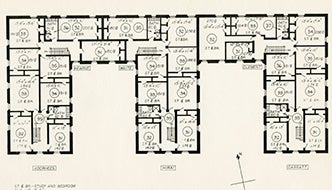
The largest incoming class ever to enter Rensselaer was welcomed this summer.
The renovation of the North Hall and E-Complex residence halls, which took place this summer to make room for the largest incoming class ever to enter Rensselaer, brings full circle the need these buildings have fulfilled for additional student housing on campus.

Originally built in 1932, the residence halls were closed in 2014 as other updated housing became available on campus.
Originally built in 1932, the residence halls were closed in 2014 as other updated housing became available on campus. The renovated buildings now accommodate 180 students in 142 rooms. The renovation included fresh painting, new flooring, improved lighting, and all-new furniture throughout, new bathroom fixtures and updated kitchens, and mechanical upgrades. The renovation also created four new study spaces, a bicycle room, and an apartment for the assistant dean.

The plans for the building clearly show why it is called the “E-Complex.”
“It is great to see North and E brought back to life with this initial renovation,” said Michael Bongiorni ’04, project manager for the renovation. “The buildings have a great history and will continue to serve this next generation of students in the coming years.”
Today’s needs reflect the buildings’ origins. As the academic programs and campus grew under President P.C. Ricketts during the early 1900s, so grew the need for student lodging. Freshmen were required to live in the Quadrangle Dormitories, but most other students lived downtown or in fraternity houses.
Using Institute land north of Avenue B (Sage Avenue), Ricketts arranged for the construction of two dormitories for upper-class students and engaged the firm of Joseph M. Lawlor, who graduated from Rensselaer with the Class of 1888. The firm of Lawlor and Haase also built several of the “green-roofed” buildings on campus.
The original residences were divided into 10 separate units and, paying homage to the storied role Rensselaer graduates played in the growth of the nation’s rail industry, each was named for an alumnus who had served as president of a railroad company.
The original residences were divided into 10 separate units and, paying homage to the storied role Rensselaer graduates played in the growth of the nation’s rail industry, each was named for an alumnus who had served as president of a railroad company.
The six units that make up the E-Complex were named for Alexander J. Cassatt, Class of 1859, Pennsylvania Railroad; William H. Clement, Class of 1835, Cincinnati Southern Railway; Frank J. Hearne, Class of 1867, Colorado & Wyoming Railway; Seijiro Hirai, Class of 1878, Imperial Government of Japan Railway; Theodore Voorhees, Class of 1869, Philadelphia & Reading Railroad; and Christopher C. Waite, Class of 1864, Columbus, Hocking Valley & Toledo Railway.

The renovated buildings now accommodate 180 students in 142 rooms. The renovation included fresh painting, new flooring, improved lighting, and all-new furniture throughout, new bathroom fixtures and updated kitchens, and mechanical upgrades.
The four units that make up North Hall were named for Souichiro Matsmoto, Class of 1876, Imperial Government of Japan Railway; Leverett S. Miller, Class of 1885, New York, Westchester & Boston Railway; George B. Roberts, Class of 1849, Pennsylvania Railroad; and Alfred Walter, Class of 1872, Lehigh Valley Railroad.
Except for the years 1961 to 1978, when North Hall was converted into laboratory and office space, these residence halls have provided much-needed living accommodations for students a few steps away from their classrooms and labs. Today, plaques bearing the names of the original building units remind the student residents of the longstanding accomplishments of graduates of Rensselaer.

